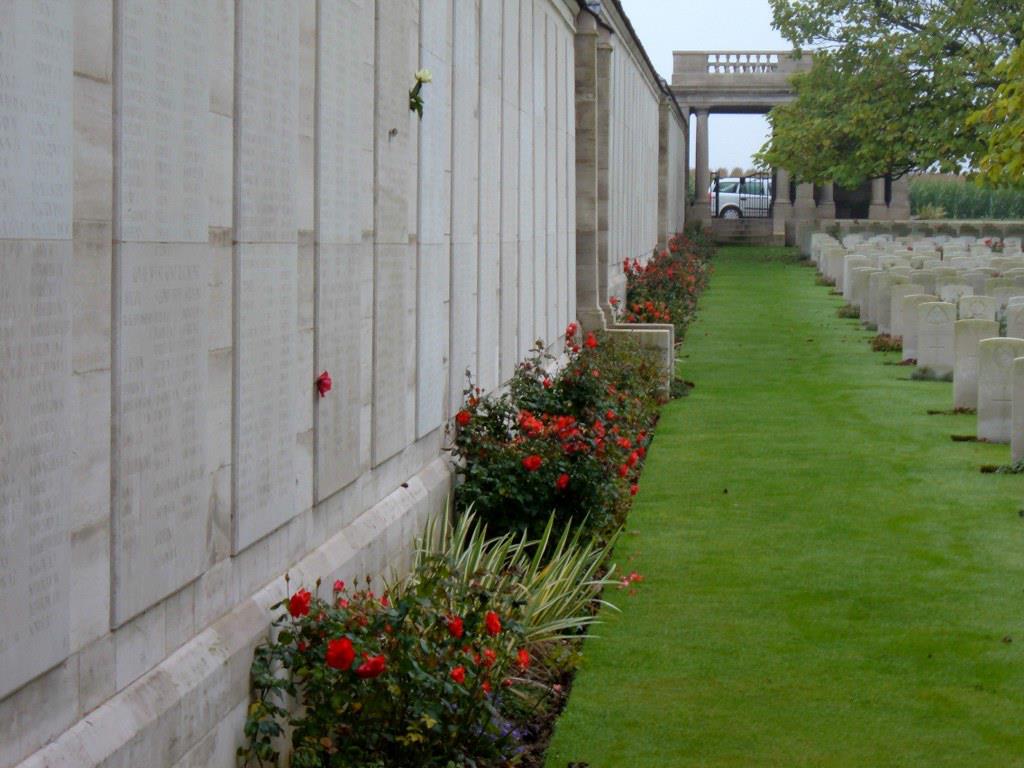JAMES BALDWIN BASSETT
Private, G/5497, Queen's Own (Royal West Kent) Regiment, 6th Battalion
Killed in Action, Battle of Loos, Flanders, France, 8 October 1915, aged about 38
Commemorated at Loos Memorial, Panel Ref 95-7. Stone No. 96a

Loos Memorial
(Click to enlarge)
James Baldwin Bassett was born at Hartfield in 1877, the son of William and Harriet Bassett. In 1881 he was living at Orchard Cottage in Hartfield with his parents and siblings William, Emma and Albert. Their given places of birth suggest that this family moved around as their father searched for work as an agricultural labourer. By 1891 the family was at Cotchford Cottage, Hartfield, and there were three further, younger siblings. James married Lucy Ann Neal in Hartfield on 11 September 1897, and they were enumerated in 1901 at Green Cottage in Hartfield with two children, Ada and May. James was employed as a plumber and house painter. In 1911 they gave their address as Ten Acre Wood in Hartfield, in accommodation of four rooms, although there were now five daughters — Ada, May, Lucy, Ivy and Margaret. James was now working as an agricultural labourer. A son, also named James, was born the following year.
Possibly, Ten Acre Wood was the name of the area rather than house, as when James signed up at Brighton on 14 January 1915, he stated that he was living at Green Cottage. He also gave his occupation as plumber once more. Only three of his children — May, Lucy and Ivy — appear under 'Particulars as to children' in his attestation papers; the other three died young. The medical history section of his papers shows him to have been 5'7" and 147 lbs, with an expansion of 2½" on a chest measurement of 35½". Physical development was recorded as good, and vision was 6-6.
James joined up at Brighton and was posted initially on 14 and 21 January 1915, and then to the British Expeditionary Force (B.E.F.). After final training at Aldershot in February 1915, the Royal West Kent Regiment was sent to France as part of the B.E.F. on 1 June 1915. They landed at Boulogne, and initially concentrated near Saint-Omer. On 6 June they were at the Meteren-Steenwerck area but had taken over a section of the front line at Ploegsteert Wood by 23 June. By the end of September they were in action in the Battle of Loos (Loos-en-Gohelle, Pas de Calais) and took over the sector from Gun Trench to Hulluch Quarries and consolidated their position under heavy artillery fire. Presumably James was involved in all these actions and survived them. However, on 8 October the regiment was engaged in repelling a heavy German infantry attack and as it was on this date that James was posted as missing he can be assumed to have been killed in action. The 6th Battalion, known as Dawson's Battalion, sustained over 350 casualties between 8 and 15 October 1915.
The Forces War Records website adds some colour to Bassett's story. The German counter-attack took place at Hulluch Quarry and is described as a 'Stalemate/German victory'. It was part of the then largest British offensive and an attempt to break the deadlock by breaking through the German lines. The battle saw the first use of gas by the British, primarily because there was a shortage of shells; these were used in a preliminary bombardment before the gas was released. 75,000 infantrymen took Loos and Hill 70, but this was quickly recovered by the Germans, partly due to shortage of ammunition and reserves on the British side. There was also fierce fighting around the Hohenzollern Redoubt at the end of September, but on 28 September, the British retreated to where they had begun three days earlier. With reinforcements arriving on 29 September, on 8 October the German counter-attack was partly repelled. However,
At 18.15 pm, 37th Infantry Brigade, led by 6th Queen's Own (Royal West Kent Regiment), attempted their own attack to capture Gun Trench, but were forced to retire without any gains.
As his body was never recovered, James Baldwin Bassett is one of the many whose names are recorded on the panels at the Loos Memorial. His medals and any other personal belongings were presumably returned to his widow, Lucy, as directed in his army record. She was also recorded as sole legatee in the Register of Soldiers' effects, receiving a total war gratuity of £5 19s 6d.
James' younger brother Albert joined up in 1914 but died on 6 February 1919 of bronchial pneumonia while still on service.
Listed on the War Memorial at Hartfield.
Pam Griffiths
2 September 2015
Updated 28 May 2019 & 6 January 2022

